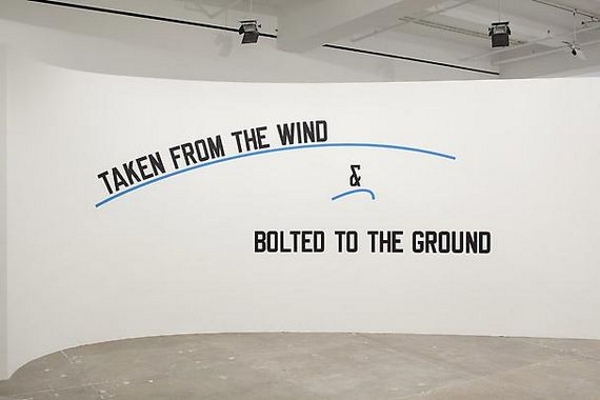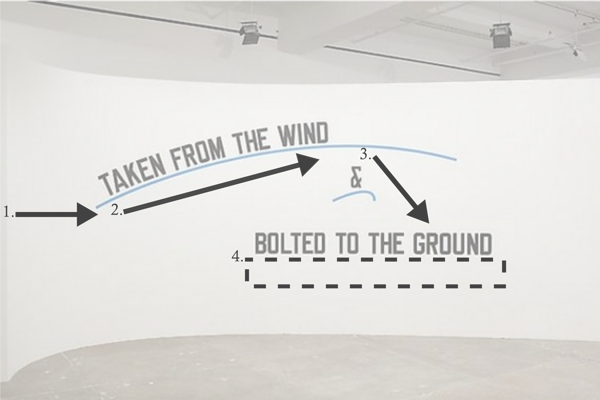This post is part of a series of blog posts called Noteworthy Artists and
Artworks. For more information about the series, please read Series Breakdown:
Noteworthy Artists and Artworks. You can find the link at the end of this post.
Lawrence Weiner is an American artist. He was born in the Bronx, New York on
10th February 1946, and currently resides in New York. Weiner is most recognised
as a conceptual artist – more specifically, the Post-Minimalist arm of
conceptualism. The artwork I will be looking at today is called Taken from The
Wind & Bolted to The Ground (fig. 1). It was part of the exhibition titled
Gyroscopically Speaking and was held in Mariam Goodman gallery, New York –
between December 2010 and January 2011.
 Figure 1: Taken From the Wind & Bolted to The Ground, 2009 by Lawrence Weiner
Figure 1: Taken From the Wind & Bolted to The Ground, 2009 by Lawrence Weiner
What is apparent with this piece is the conveying of information without a
literal depiction of it. There is no wind or ground per se, but the image has
taken a form. It does not even say what was taken, but you know what happened to
it.
For my next point, please consider the image below (fig. 2). Wiener has been
able to suggest movement using static elements. The phrase “Taken from the Wind”
is running upwards. We know to interpret it as such because of the left-to-right
nature of the English language. Comprehending “Bolted to the Ground” is how we
determine the proceeding movement is downward. And, the words “Taken” and
“Bolted” help imply the movement was a strained one. Lastly, all of this
movement is happening as you look at it, but none of it physically moves.
 Figure 2: The compositional narrative of the piece.
Figure 2: The compositional narrative of the piece.
Upon closer inspection, there are two "fragments" at play within the work. The
first fragment we are presented with is a visual one, consisting of words and
shapes. The second fragment, on the other hand, has no physical form at all.
Over time, I have fallen into the habit of referring to the first fragment as
the “immediate-visual” and the second one as the “conceptual-image”. I must,
stress here, though, I tend to use them as informal terms. I say that because
they have an asymmetric feel to them which I am, at the time of writing this,
unsure on. I cannot decide whether I should embrace or discard it or let it hang
loose as an artefact of the creation process. So, until I resolve my doubts, I
will refrain from cementing them as actual working terms. Regardless of the
validity, this observation has influenced my thoughts on art. This is most
notable in how I think about making work.
My artistic practice revolves around space as a starting point. It is here that
I would like to highlight that “starting point” is used deliberately. This is
because (amongst other things) I believe an artwork should grow over time, and
Weiner has helped expand my understanding of what that means.
During my earlier years, I had a strong preference for artworks with a strong
cerebral grounding. Unfortunately, there was a nagging frustration underlying
theses types of artworks – which I could not understanding or
shake-off. It took me a long time to recognise the cause of the
frustration. What I have come to realise is, for my artwork to convey the points
I wanted, the viewer needed to be primed with information outside of the pieces
themselves. This more often than not led to anti-climactic and confusing
experiences for the viewer.
Weiner helped me come to understand this by bringing to my attention the
importance of the "immediate-visual". The cerebral aspect I gravitated toward is
– in my opinion – at its best when you give the viewer everything they need with
the piece itself. Where they go after the initial encounter is up to them. And,
wherever they decide to go, they will not be hindered by a lack of necessary
external information on my (or my works) part.
The conceptual/meta image that arises from Taken from the Wind & Bolted to the
Ground (fig. 1)) is drawn from elements in the immediate-visual. The
dependencies on external knowledge is kept to a minimum – knowing English
will help though. Which brings us back to the previous point about growth.
For me, Weiner’s work feels like he has taken some seeds, planted them and
watched them grow. He has put everything in place and let what comes after that
develop of its own accord. What I mean by that is he has not strong armed me
into viewing his work in a particular way, especially the meta-image. He has
given the viewer some tools (I.E. visuals) and allowed him/her to do what they
want with them.
As you can see, the portrayal of Weiner "planting seeds" has been influential
for me, with regards to me adopting the idea of a "starting point". Weiner has,
also, strengthened my mental flexibility for making work in this fashion. This
flexibility is a must because you need to remember what one person knows another
might not. Thus, the amount of interpretations grows as more view the work.
For extra insight into my thinking around utilising the concept of a starting
point in my artistic practice please read another essay I have written, titled
“What Do I Mean When I Say 'Starting Point'?" Link is below.
Links